Get Fit In 3 Hours Per Week!
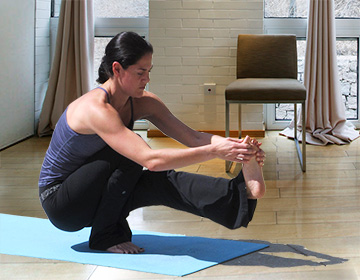 So, you've decided to get fit. Congratulations! In committing to taking care of yourself and staying healthy and fit with regular exercise, you've taken a huge step toward improving your wellness and day-to-day quality of life. You're making a huge investment in yourself that pays off in so many ways. Take a quick look at some of the wonderful benefits of exercise and a fit lifestyle:
So, you've decided to get fit. Congratulations! In committing to taking care of yourself and staying healthy and fit with regular exercise, you've taken a huge step toward improving your wellness and day-to-day quality of life. You're making a huge investment in yourself that pays off in so many ways. Take a quick look at some of the wonderful benefits of exercise and a fit lifestyle:
- You'll stay more healthy and may decrease your risk of disease and even live longer.
- You'll increase your confidence, reduce your stress, and be happier.
- You'll strengthen your heart, improve cholesterol levels, and lower your blood pressure.
- You'll sleep better, look better, and feel better.
- You'll increase your metabolism, burn calories and fat and enjoy your meals more while controlling your body weight.
- You'll move better, and keep up with your kids and/or active friends.
- You'll improve your endurance, and increase your energy level.
- You'll increase your strength and muscular endurance.
- You'll improve your flexibility and mobility.
- And, you'll control your blood sugar, improve bone strength, and much more!
Sustainable Changes Come From Setting Exciting Goals
One of the secrets of people who live fit, healthy lifestyles and who exercise regularly is having fun goals that keep them motivated. We highly recommend setting goals for your new exercise and fitness regimen because it will help you make sustainable changes in your lifestyle. Here's a helpful process for setting a motivational goal and tracking your progress:
1. Establish a specific, long-term fun goal you can look forward to. Not sure how to pick a good goal? Some people copy their friend's goal, which can work great since they will probably enjoy having a friend to workout with. But, a good goal can be anything that interests and excites you, from achieving the fitness and endurance to hike to the top of a mountain, to getting prepared to complete a distance event to raise money for your favorite charity. Plenty of goals like this are out there. All you have to do is ask friends, read the paper or talk to us.
2. Just make sure your goal is right for you. If it's exciting and motivating and achievable, it will help you make the changes you need to to reach it and that's what you're looking for: sustainable change to your lifestyle. If your goal worries you, it's usually better to reevaluate and find something more manageable and fun. You can always go for more and more challenging goals as you get fitter and fitter.
3. Once you have your long-term goal, write it down and share it with supportive friends and family members explaining why the goal is important to you. These steps help you commit.
4. Based on your long-term goal, work backward to create short-term, stepping-stone goals that can be divided up into detail-oriented action plans. So, if your goal is climbing that mountain, and it's a 5-mile climb, your short-term goals might include building up from short walks on pavement to longer hikes carry a backpack.
5. Make sure your long-term goals, short-term goals and action plans are quantifiable and time-sensitive. Considering the time the workout takes lets you fit them into your busy week and quantifying the workouts helps you focus and get the most out of them.
6. Keep a workout log (any notebook will work fine for this or simply use your wall calendar, or better, your planner), and at the end of the specified time period, review your progress toward your long-term goals, short-term goals and action plans. Over time the log lets you review what you've done and achieved giving you a great sense of satisfaction. Plus, you can learn from what worked and what setbacks you may have had if you keep good notes.
Before You Start
Prior to embarking on your new fitness program, be sure to consult with your physician. Only a doctor can ensure that you're ready to begin an exercise program. And, if you already have an idea of your goal and the workouts you'd like to do (keep reading), the Doc can also let you know if the type, frequency and intensity of planned exercise is appropriate for you.
Keep in mind that when you begin any fitness program, it's crucial to start slowly. It takes awhile to get used to the changes that make a difference in your daily life, such as the workouts, the recovery after them and the adjustment in diet and activity levels you will likely make.
Also, remember that consistency is far more important than completing long or intense workouts. Your aim should be to incorporate a basic level of exercise into your life and improve your fitness day to day; not end up injured or sick for working out too hard. Feeling tired from your workouts is to be expected, but you shouldn't be dragging around in a constant state of fatigue.
Cardio and Strength
The key components to your new fitness program should be consistent cardiovascular exercise and strength training. According to the 2008 Physical Activity Guidelines for America, the Centers for Disease Control and Prevention (CDC) recommend at least 150 minutes of "moderate-intensity" cardiovascular activity every week, along with 2 days of muscle strengthening that include all major muscle groups.
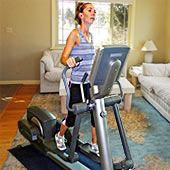 Cardiovascular exercise (also known as cardio or aerobic exercise) involves using your major muscle groups to elevate your heart rate for a sustained period of time. Cardiovascular exercise strengthens your heart, builds endurance, develops your entire circulatory system, improves lung capacity and efficiently burns calories.
Cardiovascular exercise (also known as cardio or aerobic exercise) involves using your major muscle groups to elevate your heart rate for a sustained period of time. Cardiovascular exercise strengthens your heart, builds endurance, develops your entire circulatory system, improves lung capacity and efficiently burns calories.
You'll find several extremely effective cardio options with indoor fitness equipment, such as treadmills, elliptical trainers, exercise bikes, rowing machines and steppers. And, aerobic exercise often includes popular athletic or recreational activities, such as cycling, walking, running, swimming and cross-country skiing. Plus, you can even enjoy aerobic benefits from everyday activities like mowing the lawn or playing with your kids at the park.
Strength training involves any activity that strengthens your muscles. Strength training also improves bone density, boosts your metabolism and increases your mobility and agility.
A number of diverse options are available for strength training, including free weights (like dumbbells and barbells), home gyms or other selectorized (weight stack) equipment, medicine balls, kettlebells, rubberized/elastic tubing or bands, and other activities like yoga or pilates. You can also perform bodyweight exercises like push-ups and crunches. Even, heavy yard work like shoveling or digging can also supply muscle strengthening.
Sample 3-Hour-Per-Week Workout Plan
As you start to incorporate fitness into your life, establishing a set routine or scheduling your workouts is usually a big help. While there's much discussion about the best time of day to exercise, ultimately, for most people it comes down to exercising when you can fit it into your busy schedule. Here's just one example of a how the strength training and cardio workouts can be fit into your week in just 3 hours of exercise:
| Day | Workout |
| Monday | Day Off (or do Tuesday's Strength Training today, instead |
| Tuesday | Cardio: 30 Minutes moderate; Strength Training: 15 Minutes |
| Wednesday | Cardio: 30 Minutes moderate |
| Thursday | Cardio: 30 Minutes moderate |
| Friday | Day Off (or do Saturday's Strength Training today, instead) |
| Saturday | Cardio: 30 Minutes moderate; Strength Training: 15 Minutes |
| Sunday | Cardio: 30 Minutes moderate |
Again, this workout plan simply helps organize your workouts. While there's no magic to this schedule and it doesn't need to be followed to the letter, we do have a few helpful recommendations:
- Depending on your current fitness level and exercise history, it's likely that you'll need to ease your way into your new routine. So, if you're not ready for 30 minutes of cardiovascular exercise, stick with 5 days per week, but start with an amount of time you feel is more reasonable and establish this duration as your consistent baseline. As you become comfortable with this amount of exercise, gradually add time, establishing new baselines and repeating this process until you can comfortably perform 30 minutes of cardio for each of the 5 days listed on the Sample Workout Plan.
- The strength-training sessions are scheduled for Tuesday and Saturday. On these days, start with the cardio session, because it's a great warm-up for the strength work that should immediately follow. If you decide to complete your strength training on Mondays and Fridays, you'll need to do a short warm-up to ensure that you're properly prepared for the strength session.
- If you need to alter the schedule, we still recommend spacing out your off days and allowing similar time between strength sessions for consistency and optimum recovery.
Cardio Workouts 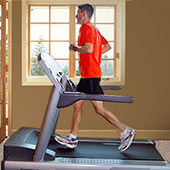 Cardiovascular training will make up the bulk of your increased activity level, and you can select from a wide range of effective options as you work toward 150 minutes of moderate-intensity aerobic exercise.
Cardiovascular training will make up the bulk of your increased activity level, and you can select from a wide range of effective options as you work toward 150 minutes of moderate-intensity aerobic exercise.
While maintaining consistency is crucial to your success, try to avoid always doing the same activity for every 30-minute cardio session, or else your workout routine may quickly become monotonous and likely lose its effectiveness. If possible, choose 2 or more cardiovascular options to help keep your workouts fresh, valuable and interesting.
Treadmills, ellipticals and other indoor cardio machines make great options for performing your aerobic workouts. Why? You can easily control all the variables! For example, on a treadmill, you have full control over the speed and incline, meaning you can fine-tune a workout's intensity to ensure that you're working out at a moderate level. And, typically, elliptical trainers, exercise bikes and rowers all let you adjust the resistance while you move at your preferred speed.
The best method for maintaining the proper aerobic intensity is monitoring your heart rate. Many cardio machines now include heart-rate monitors that deliver precise feedback on a workout's intensity. And, convenient, stand-alone heart-rate monitors are also available, offering the ability to accurately track your heart rate on any piece of fitness equipment or while exercising outdoors. For a moderate-intensity workout, the CDC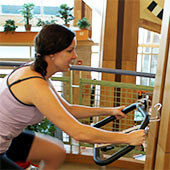 recommends that you exercise between 50 to 70% of your maximum heart rate.
recommends that you exercise between 50 to 70% of your maximum heart rate.
We're happy to help you with questions regarding your maximum heart rate, machines offering heart-rate monitoring, and stand-alone heart-rate monitors.
Another, less objective way of determining your exertion level is the "talk test." As your effort level increases, you want to make sure you can still comfortably carry on a conversation. If you can't, you're working too hard. On the other hand, if you can not only talk, but sing, your effort level is too low.
Follow these helpful guidelines to keep your workouts effective:
- Your warm-up should be contained within your 30-minute cardio session. Spend the first 5 minutes of the workout gradually building from an easy to moderate effort.
- Spend the last few minutes of your half-hour workout cooling down; gradually dropping from a moderate to easy effort.
- If possible, be sure to have water on hand to stay hydrated. That can keep you from cutting your workout short.
- Especially early on, don't be concerned with maintaining a certain pace or traveling a set distance.
- Stretch! Follow your cardio with some light stretching of the muscles groups used during the workout.
Mini Workouts
If you aren't always able to find 30 minutes for a continuous aerobic workout, try for the next best thing: 2 or 3 shorter sessions throughout the day that add up to 30 minutes. While you may not achieve the identical cardiovascular benefits as you would during a non-stop, 30-minute session, the activity level and calorie burning will be the same. Here are several easy ideas for squeezing in mini-workouts throughout your day:
- During your workday, you could take 10 minutes from each of 2 breaks and 10 minutes during your lunch break to walk or climb stairs. While you may not achieve the identical cardiovascular benefits, you'll be getting away from your work station, increasing your activity level and burning calories. Everything adds up!
- While your child practices soccer or baseball, walk laps around the field or park.
- After you drop your child off at the bus, take the long way back.
- Park as far away as possible at the grocery store or mall.
Note: these mini workouts should not be the norm. The bulk of your aerobic workouts should be single, continuous, 30-minute workouts.
Strength Workouts
Like cardio training, mixing up your strength training can make each session more valuable and considerably more interesting. Take a look at many of the options that are available for home fitness:
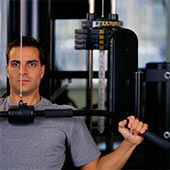 Traditional home gyms typically offer a fixed range of motion for safe weight lifting, plus quick changes between weights and exercises.
Traditional home gyms typically offer a fixed range of motion for safe weight lifting, plus quick changes between weights and exercises.- Functional trainers or cable gyms allow users to define their own range of motion for strength training that specifically mirrors everyday activities and athletic movements. These systems usually offer quick adjustments to the weight stack and a wide range of exercise positions.
- Free weights like barbells and dumbbells let you perform a wide range of effective, user-defined range-of-motion exercises. Barbells and dumbbells can be used while standing or with a bench, fitness ball, balance disk or other fitness tools.
- Rubberized/elastic tubing and bands allow a lightweight, travel-friendly option for strength training that's especially safe and effective for muscle and joint rehabilitation exercises.
- Medicine balls allow user-defined motions and make a great choice for sport-specific conditioning, partner drills, plus core strength and stability work.
- Kettlebells are dynamic tools for full-body strengthening and functional fitness.
- Helpful fitness tools like mats, pull-up bars, push-up bars and fitness balls let you comfortably perform effective bodyweight exercises.
With so many choices available, we're happy to discuss all your options with you and help you determine which methods will work best for you.
If your strength training experience is limited, the following guidelines should help when structuring and performing a traditional strength training workout:
- Warm up. Either perform your strength workout immediately following a cardio workout or a short cardio warm-up.
- Choose one exercise from each muscle group (see chart below).
- Perform 1 set of 10 to 15 repetitions. You should lift enough weight so that you can only complete your planned repetitions. Your final repetitions should be somewhat difficult and performed with proper form.
- Increase the amount of weight lifted as you grow stronger and the exercises become easier.
- Make sure to breathe while lifting.
- Because you're utilizing different muscle groups for each exercise, your rest between exercises should be minimal.
- Keep your workouts fresh and effective by varying the strength training exercises you use for each muscle group.
| Muscle Group | Strength Training Exercises |
| Legs & Hips | Squats, Leg Presses, Lunges, Leg Curls, Leg Extensions, Calf Presses, Calf Raises |
| Back | Lat Pull-Downs, Pull-Ups/Chin-Ups, Seated Rows, Shrugs, Bent-Over Rows |
| Chest | Bench Presses, Flys, Push-Ups |
| Abdominals | Crunches, Sit-Ups, Oblique Crunches, Vertical Knee Raises |
| Shoulders | Shoulder Presses, Lateral Raises, Front Raises |
| Arms | Biceps Curls, Triceps Extensions, Triceps Push-Downs, Dips |
The Next Step
When you get to the point where you've comfortably established your fitness routine and you find it easy to complete your current workouts, there are a number of ways to improve and expand your existing program:
- Look for ways to be more active throughout your week, even on your off days. Take your dog for a walk, catch up on yard work or ride your bike to the store.
- Spend time stretching before bedtime. Besides adding a daily boost to your flexibility, it will help you relax and improve your sleep.
- Gradually add a minute or two to one of your aerobic sessions to develop a long workout.
- Improve your workout quality by adding intensity to one of your cardio workouts. Inside, this might include using a treadmill or elliptical trainer's interval program. Outside, this could be adding hills to a walking, running or cycling route.
- As your strength training progresses, consider adding another set of 10 to 15 repetitions.
- When strength training, increase your weight/resistance, add another set or additional repetitions, incorporate new exercises, and utilize different strength training tools or machines.
You may catch yourself dwelling on the enormity of making healthy, lifelong changes. Instead, take one day at a time and do your best to enjoy each day's workout as it comes.
We're excited that you've embraced an increased activity level and a healthier life. We're confident you'll love your increased energy level, superior endurance, improved strength and better mobility. Enjoy the journey!
